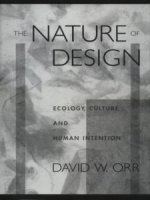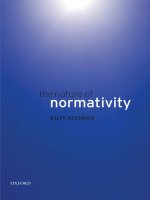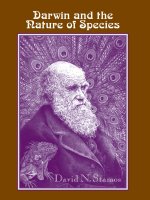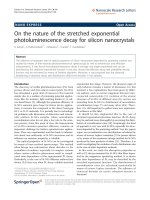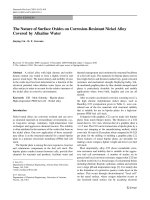the nature of design - oxford university press
Bạn đang xem bản rút gọn của tài liệu. Xem và tải ngay bản đầy đủ của tài liệu tại đây (1.15 MB, 247 trang )
The Nature of Design
THE
NATURE
of DESIGN
Ecology, Culture, and Human Intention
David W. Orr
1
2002
3
Oxford New York
Auckland Bangkok Buenos Aires Cape Town Chennai
Dar es Salaam Delhi Hong Kong Istanbul Karachi Kolkata
Kuala Lumpur Madrid Melbourne Mexico City Mumbai Nairobi
São Paulo Shanghai Singapore Taipei Tokyo Toronto
and an associated company in Berlin
Copyright © 2002 by Oxford University Press, Inc.
Published by Oxford University Press, Inc.
198 Madison Avenue, New York, New York 10016
www.oup.com
Oxford is a registered trademark of Oxford University Press
All rights reserved. No part of this publication may be reproduced,
stored in a retrieval system, or transmitted, in any form or by any means,
electronic, mechanical, photocopying, recording, or otherwise,
without the prior permission of Oxford University Press.
Library of Congress Cataloging-in-Publication Data
Orr, David W., 1944–.
The nature of design : ecology, culture, and human intention / by David W. Orr.
p. cm.
Includes bibliographical references (p. ).
ISBN 0-19-514855-X
1. Nature—Effect of human beings on.
2. Human ecology—Moral and ethical aspects.
3. Environmental responsibility.
4. Global environmental change.
I. Title.
GF75 .O77 2002
304.2'8—dc21 2001036413
We gratefully acknowledge permission from Blackwell Science, Ltd., to reprint
in this book, in somewhat altered form, material from the following articles by
David W. Orr that were originally published in Conservation Biology:“Technologi-
cal Fundamentalism” (8:2, June 1994); “Twine in the Baler” (8:4, December 1994);
“Conservatism and Conservation” (9:2, April 1995); “None So Blind” (9:5, October
1995); “Slow Knowledge” (10:3, June 1996); “Architecture as Pedagogy II” (11:3,
June 1997); “Speed” (12:1, February 1998); “The Limits of Nature and the Nature
of Limits” (12:4; August 1998); “The Architecture of Science” (13:2, April 1999);
“Verbicide” (13:4, August 1999); “Education, Careers, Callings” (13:6, December
1999); “2020: A Proposal” (14:2, April 2000); “Ideasclerosis I” (14:4, August 2000);
Ideasclerosis II” (14:6, December 2000).
987654321
Printed in the United States of America
on recycled, acid-free paper
For Wil
Acknowledgments
For the past six years, ecological design has been more than an ab-
straction for me. The essays that follow originated in physical and
intellectual proximity to an ecological design project on the campus
of Oberlin College described in chapter 14. What began as a fairly
straightforward design and construction project became a crash
course in architecture, engineering, materials analysis, ecological engi-
neering, landscape ecology, energy analysis, philosophy, institutional
politics, and fund-raising. During that time it was my privilege to
work with some of the most remarkable designers of our time. To all
of the participants in that project I owe a large debt: Ray Anderson,
David Austin, Bill Browning, Kevin Burke, Leo Evans, Carol Franklin,
Chris Hays, Mark Hoberecht, Amory Lovins, John Lyle, Bill McDo-
nough, Dave Nelson, Ron Perkins, Russell Perry, Mark Rusitsky, Bob
Scheren, Michael Shaw, Stephen Strong, John Todd, Martin Trout-
man, and Adrian Tuluca. They persevered on a tough project. I owe a
large debt to friends and colleagues here and elsewhere particularly
David Benzing, Peter Buckley, Fritjof Capra, Tony Cortese, Nancy
Dye, Karen Florini, Dierdre Holmes, Jon Jensen, Adam Lewis, Peter
Lewis, Al MacKay, Brad Masi, Gene Matthews, Carl McDaniel, John
Petersen, John Powers, Michael Stranahan, Paige Wiegman, and
Cheryl Wolfe. I thank David Ehrenfeld and Gary Meffe, both for their
editorial skill that improved many of these essays and for their en-
couragement. I am grateful to Island Press for permission to include
“The Ecology of Giving and Consuming” from Consuming Desires, ed.
Roger Rosenblatt (1999); to MIT Press for permission to include
“Loving Children” from Children and Nature: Psychological, Sociocul-
tural, and Evolutionary Investigations, ed. Peter H. Kahn Jr. and
Stephen R. Kellert (2002); to Wild Earth for permission to include
“The Great Wilderness Debate, Again”; and to Blackwell Science for
permission to reprint material from Conservation Biology included
here in chapters 3–17. Finally, this book is dedicated to my brother
Wilson, with gratitude and love.
viii ACKNOWLEDGMENTS
Contents
I. The Problem of Ecological Design
1. Introduction: The Design of Culture and the
Culture of Design 3
2. Human Ecology as a Problem of Ecological Design 13
II. Pathologies and Barriers
3. Slow Knowledge 35
4. Speed 43
5. Verbicide 53
6. Technological Fundamentalism 61
7. Ideasclerosis 68
8. Ideasclerosis, Continued 75
III. The Politics of Design
19. None So Blind: The Problem of Ecological Denial
(with David Ehrenfeld)85
10. Twine in the Baler 91
11. Conservation and Conservatism 97
12. A Politics Worthy of the Name 104
13. The Limits of Nature and the Educational Nature
of Limits 118
IV. Design as Pedagogy
14. Architecture and Education 127
15. The Architecture of Science 135
16. 2020: A Proposal 143
17. Education, Careers, and Callings 152
18. A Higher Order of Heroism 160
V. Charity, Wildness, and Children
19. The Ecology of Giving and Consuming 171
20. The Great Wilderness Debate, Again 187
21. Loving Children: The Political Economy of Design 198
Bibliography 221
Index 233
x CONTENTS
§ 1
THE PROBLEM OF ECOLOGICAL DESIGN
1
Introduction: The Design of Culture
and the Culture of Design
Environmentalists are often regarded as people wanting to stop one
thing or another, and there are surely lots of things that ought to be
stopped. The essays in this book, however, have to do with begin-
nings. How, for example, do we advance a long-delayed solar revolu-
tion? Or begin one in forest management? Or materials use? How do
we reimagine and remake the human presence on earth in ways that
work over the long haul? Such questions are the heart of what the-
ologian Thomas Berry (1999) calls “the Great Work” of our age. This
endeavor is nothing less than the effort to harmonize the human en-
terprise with how the world works as a physical system and how it
ought to work as a moral system. In the past two centuries the human
footprint on earth has multiplied many times over. Our science and
technology are powerful beyond anything imagined by the confident
founders of the modern world. But our sense of proportion and depth
of purpose have not kept pace with our merely technical abilities.
Our institutions and organizations still reflect their origins in another
time and in very different conditions. Incoherence, disorder, and
violence are the hallmarks of the modern world. If we are to build a
better world—one that can be sustained ecologically and one that
sustains us spiritually—we must transcend the disorder and fragmen-
tation of the industrial age. We need a perspective that joins the hard-
won victories of civilization, such as human rights and democracy,
with a larger view of our place in the cosmos—what Berry calls “the
universe story.” By whatever name, that philosophy must connect us
to life, to each other, and to generations to come. It must help us to
rise above sectarianism of all kinds and the puffery that puts human
interests at a particular time at the center of all value and meaning.
When we get it right, that larger, ecologically informed enlighten-
ment will upset comfortable philosophies that underlie the modern
world in the same way that the Enlightenment of the eighteenth cen-
tury upset medieval hierarchies of church and monarchy.
The foundation for ecological enlightenment is the 3.8 billion
years of evolution. The story of evolution is a record of design strate-
gies as life in all of its variety evolved in a vast efflorescence of biolog-
ical creativity. The great conceit of the industrial world is the belief
that we are exempt from the laws that govern the rest of the creation.
Nature in that view is something to be overcome and subordinated.
Designing with nature, on the other hand, disciplines human inten-
tions with the growing knowledge of how the world works as a phys-
ical system. The goal is not total mastery but harmony that causes no
ugliness, human or ecological, somewhere else or at some later time.
And it is not just about making things, but rather remaking the
human presence in the world in a way that honors life and protects
human dignity. Ecological design is a large concept that joins science
and the practical arts with ethics, politics, and economics.
In one way or another all of the important questions of our age
have to do with how we get on with the Great Work, transforming
human activity on the earth from destruction to participation and
human attitudes toward nature from a kind of autism to a competent
reverence. It would be foolish to think that what has taken several
centuries or longer can be undone quickly or even entirely. But it
would also be the height of folly to continue on our present course or
to conclude that we are doomed and give up hope. For most of us the
Great Work must begin where we are, in the small acts of everyday
4 THE PROBLEM OF ECOLOGICAL DESIGN
life, stitching together a pattern of loyalty and faithfulness to a higher
order of being. The hallmarks of those engaged in Great Work every-
where must be largeness of heart, breadth of perspective, practical
competence, moral stamina, and the kind of intelligence that discerns
ecological patterns.
This is a tall order, but we have a heritage of ecological design in-
telligence available to us if we are willing to draw on it. The starting
point for ecological design is not some mythical past, but the heritage
of design intelligence evident in many places, times, and cultures prior
to our own. We don’t need to reinvent wheels. What we will need in
the decades ahead is to rediscover and synthesize, as well as invent.
Let me illustrate with four examples.
1. Several days after the bombing of the Murrah Federal Build-
ing in Oklahoma City in 1995, an Amish friend of mine with a well-
developed sense of humor called from a pay phone to inform me that
no Amish person was involved in the crime. I responded by saying
that I was not particularly surprised. “Good,” he replied, “I just
wanted to clarify that in your mind.” After a pause he added: “You
know if the Amish were involved, the getaway buggy would have
been blown up.”
My friend usually has a point to make. This time it was simply a
humorous way of saying that if the horse is your primary mode of
transportation, there are some things you cannot do. Whatever malice
may be hidden in the heart, the speed and power of the horse sets
limits to the havoc one can cause. If the horse is your primary form of
transportation, you cannot haul enough diesel and fertilizer to blow
up large buildings, and you could not escape the ensuing destruction
anyway. A horse-drawn buggy has a radius of about eight miles in hilly
country, and if you have chores to finish by suppertime, you cannot
conveniently shop until you drop. And if you could, you still could
not haul it all home. The use of draft animals also limits the amount
of land one can farm, which, in turn, limits the desire to take over a
neighbor’s farm.
In Amish culture, in other words, the horse functions like a me-
chanical governor on a machine. The horse sets a standard of sorts for
human activity and a way for the culture to say no to some possibili-
ties, which means saying yes to better ones. The Amish voluntarily ac-
cept the limits imposed by the horse and the discipline of living in a
close-knit community. People in industrial culture, on the other hand,
INTRODUCTION 5
have no functional equivalent of the horse and accept few limits be-
yond those of what is assumed to be cost-effectiveness. The Amish
and most traditional cultures can sustain themselves indefinitely
within the ecological limits of their regions. They contribute little or
nothing to climatic change, cancer rates, and the loss of biodiversity,
and they are invulnerable to any technological failure originating
within their own community. Modern societies, on the other hand,
are increasingly vulnerable to a long list of ecological, economic, tech-
nological, and social threats. The question then arises whether we also
need some functional equivalent of the horse in order to become sus-
tainable. If so, what could it be?
2. The hamlet of Harberton, with a population of perhaps 100,
is no more than 4 miles from the city of Totnes (Devon, U.K.) with a
population of 10,000. The road connecting the two, however, is a sin-
gle lane flanked by high hedgerows which traverses an ancient and
competently used countryside. Drivers meeting on the lane connect-
ing Harberton and Totnes must decide who will back up to let the
other through. The process works with a civility and friendliness that
is surprising to an American driver accustomed to speed and rude-
ness. In fact, the entire scene is unexpected. In, say, Ohio, there would
be little or no countryside between the two places. Developers would
have filled the four miles with malls, scenic motels, billboards, parking
lots, fast-food joints, and poorly constructed housing. In contrast, the
people of Devon have maintained and in some ways have improved a
landscape continuously inhabited since the Neolithic era. It is a land-
scape of rolling hills, stone buildings clustered into villages, small
fields, dairy farms, sheep pastures, hedgerows, and narrow roads. To
the north is an expanse known as Dartmoor, to the south is the Eng-
lish channel and port towns such as Dartmouth from which the
Mayflower sailed. This was an ancient landscape before the birth of
Socrates and would still be mostly familiar to its early inhabitants.
How is it that human occupation and use of this land for perhaps
10,000 years has not led to its desecration?
3. Western agriculture imposed on the island of Bali displaced
an agricultural system of remarkable productivity that had thrived
for a thousand years or more. Balinese agriculture was controlled by
a system of temples presided over by a priesthood that orchestrated
the distribution of irrigation water. The entire process was cali-
brated to the seasons, pests, and differing crop needs by a complex
6 THE PROBLEM OF ECOLOGICAL DESIGN
calendar worked out over many centuries. That intricate, resilient,
and highly productive system was displaced by the Green Revolu-
tion in the 1970s administered by experts who regarded agriculture
as merely technical. The results were disastrous. Crops failed, pests
multiplied, and the society unraveled. The Balinese system of agri-
culture had been a remarkable blend of religion with hydrological
and biological management. The imposition of technocratic West-
ern agriculture undid in a few years what had taken hundreds of
years to create largely because “the managerial role of the water
temples was not easily translated into the language of bureaucratic
control” (Lansing 1991, 127). Now much of that system based on
Western science and agronomy has been dismantled. But how can a
system based on superstition work where one purportedly based on
science does not?
4. Designer Victor Papenek once identified the Inuit people of
northern Alaska as the best designers in the world. They are, he be-
lieved, “forced into excellence by climate, environment, and their
space concepts. At least equally important is the cultural baggage
they carry with them” (Papenek 1995, 223). Living in spare environ-
ments frozen through much of the year, the Inuit people have had to
develop acute powers of observation, memory, and senses. They can
repeat a long trek using nothing more than the memory of the same
journey made years before. With eyes closed they can draw accurate
maps of their coastline. And their best maps drawn long ago rival the
best maps we can make with satellite data. Their homing sense re-
sembles that of animals that can find their way home through adverse
conditions. They make little distinction between space and time.
They observe details with keenness lost to Western people. Can de-
sign ingenuity be bred into a culture by adversity?
Such examples reveal the importance of the relation between
culture and the long-term human prospect in particular places. There
are, of course, many other examples, such as Helena Norberg-Hodge’s
(1992) study of the impact of Westernization on the people of
Ladakh and Gary Nabhan’s (1982) study of the Papago peoples of the
desert Southwest. The history of settled people in many places re-
veals the fact that culture and the ecology of particular places have
often been joined together with great intelligence and skill. The re-
sults, however imperfect, are habitats in which culture and nature
have flourished together over many generations. They offer clues
INTRODUCTION 7
about how the human enterprise has, under some conditions, been
sustained and what might be required to extend the life of our own.
Having been shaped by a century or more of cheap oil, industri-
alism, and hyperindividualism, we have a difficult time understanding
what might be learned from such seemingly archaic examples. Yet as
tourists we are drawn in large numbers to places like Amish country
or Devon to snap a few photographs and after a brief visit return to
other places that are not nearly as wholesome and to lives far more
hectic. We seldom see any relation between the two. What can be
learned from well-used landscapes and settled societies wherever
they exist is the importance of local culture as the mediator between
human intentions and nature. Design for settled peoples is more than
the work of a few heroic individuals. The process by which cultures
and communities evolve over long periods of time in particular places
is manifest not so much in discrete and spectacular things as it is in
overall stability and long-term prosperity. Indeed, it is the absence of
spectacular monuments like pyramids, glittering office towers, and
shopping malls that signals the intention of people to settle in and
stay a while. Design in such places is a cultural process extending over
many centuries that has certain identifiable characteristics.
In contrast to the frenetic pace of industrial societies, settled cul-
tures work slowly, rather like “a patient and increasingly skillful love-
making that [persuades] the land to flourish” (Hawkes 1951, 202).
Moreover, settled cultures seldom exceed what can be called a human
scale. They persist mostly, but not exclusively, on local resources. In
Devon, most houses and barns are made from local timber and stone
and roofed with local slate or thatch. Fences are grown as hedgerows
over centuries. In Amish country, barns and houses are still built from
local timber by the community in barn raisings. The culture is mostly
powered by sunshine in the form of grass for animals and by wind for
pumping water. Settled cultures grow most of their food. They pro-
vide their own livelihood. To their young they impart the skills and
aptitudes necessary to live in a particular place, not the generic job
skills necessary for the anywhere-and-everywhere industrial econ-
omy. Instead of individual brilliance, design results from an intelli-
gence that is deeply embedded in the culture.
Settled cultures tend to limit excess in a variety of ways. Showi-
ness, ego trips, great wealth, huge homes, hurry, and excessive con-
sumption are mostly discouraged, while cooperation, neighborliness,
8 THE PROBLEM OF ECOLOGICAL DESIGN
competence, thrift, responsibility, and self-reliance are encouraged.
I doubt that these traits are mentioned often, but they are manifest in
the routines of daily life. It is simply the way things are. Western cul-
ture with its worship of egoism, doing your own thing, consumption,
the cult of wealth, and keeping one’s options open is simply incom-
prehensible from the viewpoint of settled people. Whatever their
particular theology, settled cultures limit the expression of the seven
deadly sins of pride, envy, anger, sloth, avarice, gluttony, and lust sim-
ply because these vices make living in close quarters difficult if not
impossible. In Western culture, as Lewis Mumford (1961, 346) once
noted, the deadly sins have mutated into “virtues” that feed economic
obesity. When the two cultures have clashed, settled people have re-
garded industrial people as seriously deranged. But more often than
not settled people are either subsequently seduced by materialism or
swept away by the sheer power of the more aggressive culture.
Settled cultures, without using the word “ecology,” have designed
with ecology in mind because to do otherwise would bring ruin,
famine, and social disintegration. Out of necessity they created har-
mony between intentions and the genius of particular places that pre-
served diversity both cultural and biological capital; utilized current
solar income; created little or no waste; imposed few unaccounted
costs; and supported cultural and social patterns. Cultures capable of
doing such things work slowly and from the bottom up. There is no
amount of individual cleverness that could have created the intricate
cultural patterns that have preserved the landscape of Devon or
grown rice in Bali for millennia, nor any that could have created a cul-
ture as stable and nondestructive as that of the Amish. On the con-
trary, these evolved as a continual negotiation within a community
and between the community and the ecological realities of particular
places. Such cultures are not the result of scientific research so much
as continual trial and error at a scale small enough to give quick feed-
back on cause and effect. Ecological design, then, requires not just a
set of generic design skills but rather the collective intelligence of a
community of people applied to particular problems in a particular
place over a long period of time.
Ecological design at the level of culture resembles the structure
and behavior of resilient systems in other contexts in which feedback
between action and subsequent correction is rapid, people are held
accountable for their actions, functional redundancy is high, and
INTRODUCTION 9
control is decentralized. At a local scale, people’s actions are known
and so accountability tends to be high. Production is distributed
throughout the community, which means that no one individual’s
misfortune disrupts the whole. Employment, food, fuel, and recre-
ation are mostly derived locally, which means that people are buffered
somewhat from economic forces beyond their control. Similarly, the
decentralization of control to the community scale means that the
pathologies of large-scale administration are mostly absent. Moreover,
being situated in a place for generations provides long memory of the
place and hence of its ecological possibilities and limits. There is a kind
of long-term learning process that grows from the intimate experi-
ence of a place over time of the kind once described by English wheel-
wright George Sturt ([1923] 1984, 66) as “the age-long effort of Eng-
lishmen to fit themselves close and ever closer into England.”
Beneath what we can see in settled cultures, there is a deeper
worldview that we can barely comprehend. In contrast to the linear
thinking characteristic of Westernized people, Native American cul-
tures, for example, had a more integrated view of the world in which
they lived. In Vine Deloria’s words, “The traditional Indian stood in
the center of a circle and brought everything together in that circle.
Today we stand at the end of a line and work our way along that line,
discarding or avoiding everything on either side of us” (1999, 257).
There was (and for some, still is) a view that all that exists is bound in
a kind of supportive kinship. These relationships imposed responsibil-
ities on humans to perform tasks that upheld the “basic structure of
the universe” and ensured that all life forms were treated with respect
and dignity (ibid., 131). Humans were intended to live “as relatives”
with all animals and learn from them (ibid., 237).“Apart from partic-
ipation in this network,” Deloria says,“Indians believe a person simply
does not exist” (ibid., 132).
The idea that humans are embedded in a network of obligation
and are kin to all life explains why settled cultures often regarded
economics as a kind of gift relationship. “In most Indian communities
in the old days the most respected person was the one who gave
freely of physical wealth, who showed a concern for the unfortunate,
and who allowed weaker members of the community to rely on
him/her” (Deloria 1999, 132). The essence of the economy is the
simple and profoundly ecological idea that “the gift must always
move” (Hyde 1983, 4). Tribal people often evolved complicated cer-
10 THE PROBLEM OF ECOLOGICAL DESIGN
emonies, like the potlatch of the Native American tribes of the North
Pacific, in which wealth was given away, destroyed, or discarded. Be-
neath such customs is an ecological view of the world that involves
understanding “that what nature gives to us is influenced by what we
give to nature” (Deloria 1999, 19). When wealth is no longer re-
garded as a gift to be passed from person to person, then and only
then does scarcity appear.
Such relationships were not religious abstractions, but central to
the way Native Americans related to the places in which they lived.
They made no clear distinctions between themselves physically and
the land in which they dwelled. Land contained the memory of past
deeds and the spirits of their ancestors. Settled people have always
known where they would be buried and with whom.“Our memory of
land is a memory of ourselves and our deeds and experiences,” in
Deloria’s words (1999, 253). We who regard land as a commodity to
be bought and sold or as a resource can scarcely comprehend such
a view. Our lack of comprehension is, in the view of tribal people, a
mark of our adolescence and immaturity.
This book is not an argument to return to some mythic condition
of ecological innocence. No such place ever existed. It begins, how-
ever, with an acknowledgment that we have important things to re-
learn about the arts of longevity—what is now called “sustainabil-
ity”—from earlier cultures and other societies. Many of those cultures
appear to us as quaintly archaic if not utterly incomprehensible. But
in the larger sweep of time, our emphasis on economic growth, con-
sumption, and individualism will be even less understandable to sub-
sequent and, one hopes, wiser generations. Carrying out the Great
Work of making an ecologically durable and decent society will re-
quire us to confront the deeper cultural roots of our problems and
grow out of the faith that we can meet the challenge of sustainability
without really changing much. The evidence, I think, shows that we
will have to change a great deal and mostly in ways that we will come
to regard as vastly better than what exists now and certainly better
than what is in prospect.
This is a design challenge like no other. It is not about making
greener widgets but how to make decent communities that fit their
places with elegant frugality. The issue is whether the emerging field
of ecological design will evolve as a set of design skills applied as
patchwork solutions on a larger pattern of disorder or whether design
INTRODUCTION 11
will eventually help to transform the larger culture that is badly in
need of a reformation. I hope for the latter. Green consumerism or
even greener corporations are Band-Aids on wounds inflicted by
economy grown too indifferent to real human needs and pressing
problems of long-term human survival. Corporations certainly need
to be improved, but the larger design problem has to do with the
structure of an economy that promotes excess consumption and
human incompetence, concentrates power in too few hands, and de-
stroys the ties that bind people together in community. The problem
is not how to produce ecologically benign products for the consumer
economy, but how to make decent communities in which people
grow to be responsible citizens and whole people.
The essays that follow aim to broaden the concept of ecological
design, explore various pathologies that prevent it, and sketch the ed-
ucational implications of design. In the final section the essays lay out
a standard for design that is oriented to generosity in the large sense of
the word, the preservation of wildness and wilderness, and the design
of a culture that protects its children.
12 THE PROBLEM OF ECOLOGICAL DESIGN
2
Human Ecology as a Problem
of Ecological Design
Man is everywhere a disturbing agent. Wherever he plants his
foot, the harmonies of nature are turned to discords.
—George Perkins Marsh
The Problem of Human Ecology
Whatever their particular causes, environmental problems all share
one fundamental trait: with rare exceptions they are unintended,
unforeseen, and sometimes ironic side effects of actions arising from
other intentions.
1
We intend one thing and sooner or later get some-
thing very different. We intended merely to be prosperous and
1. Our ecological troubles have been variously attributed to Judeo-Christian
religion (White 1967), our inability to manage common property resources
healthy but have inadvertently triggered a mass extinction of other
species, spread pollution throughout the world,and triggered climatic
change—all of which undermines our prosperity and health. Environ-
mental problems, then, are mostly the result of a miscalibration
between human intentions and ecological results, which is to say that
they are a kind of design failure.
The possibility that ecological problems are design failures is per-
haps bad news because it may signal inherent flaws in our perceptual
and mental abilities. On the other hand, it may be good news. If our
problems are, to a great extent, the result of design failures, the obvi-
ous solution is better design, by which I mean a closer fit between
human intentions and the ecological systems where the results of our
intentions are ultimately played out.
The perennial problem of human ecology is how different cul-
tures provision themselves with food, shelter, energy, and the means
of livelihood by extracting energy and materials from their surround-
ings (Smil 1994). Ecological design describes the ensemble of tech-
nologies and strategies by which societies use the natural world to
construct culture and meet their needs. Because the natural world is
continually modified by human actions, culture and ecology are shift-
ing parts of an equation that can never be solved. Nor can there be
one correct design strategy. Hunter-gatherers lived on current solar
income. Feudal barons extracted wealth from sunlight by exploiting
serfs who farmed the land. We provision ourselves by mining ancient
sunlight stored as fossil fuels. The choice is not whether or not human
societies have a design strategy, but whether that strategy works eco-
logically and can be sustained within the regenerative capacity of the
particular ecosystem. The problem of ecological design has become
more difficult as the human population has grown and technology
has multiplied. It is now the overriding problem of our time, affecting
virtually all other issues on the human agenda. How and how intelli-
gently we weave the human presence into the natural world will re-
14 THE PROBLEM OF ECOLOGICAL DESIGN
such as ocean fisheries (Hardin 1968), lack of character (Berry 1977), gender
imbalance (Merchant 1980), technology run amuck (Mumford 1974), disen-
chantment (Berman 1989), the loss of sensual connection to nature (Abram
1996), exponential growth (Meadows 1998), and flaws in the economic sys-
tem (Daly 1996).

